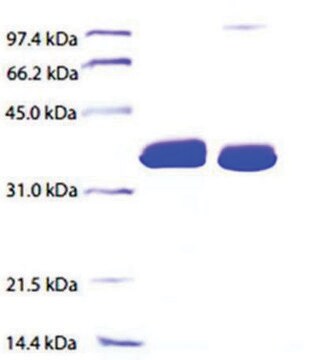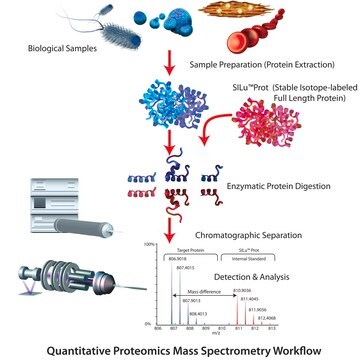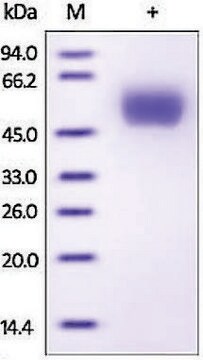推荐产品
一般說明
Significant quantities of ApoE are produced in liver and brain and to some extent in almost every organ. ApoE is an important constituent of all plasma lipoproteins. It′s interaction with specific ApoE receptor enables uptake of chylomicron remnants by liver cells, which is an essential step during normal lipid metabolism. ApoE exists in three major isoforms; E2, E3, and E4, which differ from one another by a single amino-acid substitution. E3 is the most common isoform and is present in 40-90% of the population. Recombinant human ApoE3 is a 34.0 kDa protein containing 299 amino acid residues. The recombinant ApoE3 was manufactured using animal origin free technology.
應用
Human ApoE has been used to study the role of apoE in the activity of LNP (lipid nanoparticles) in order to determine if ApoE has a role to play in the delivery of siRNA to hepatocytes.
生化/生理作用
ApoE belongs to a group of proteins that bind reversibly with lipoprotein and play an important role in lipid metabolism. In addition to facilitating solublization of lipids, these proteins help to maintain the structural integrity of lipoproteins, serve as ligands for lipoprotein receptors, and regulate the activity of enzymes involved in lipid metabolism. Apart from participating in the metabolism of plasma lipoproteins, apo-E also interacts with several proteoglycans, such as heparin. The interaction of lipoproteins with proteoglycans in the walls of arteries has been associated with cholesterol deposition linked to atherosclerosis. It is found to be a constituent of several lipoproteins and serves as a ligand for the LDL (low density lipoprotein) receptor, thereby regulating cholesterol and triglyceride homeostasis.
外觀
Sterile filtered and lyophilized from 20 mM sodium phosphate.
重構
Centrifuge the vial prior to opening. Avoid freeze-thaw cycles.
Reconstitute in 5 mM Sodium Phosphate pH 7.8 + 0.5 mM DTT to a concentration of 0.1-1.0 mg/mL. The solution can then be diluted into other aqueous buffers and stored at 4°C for 1 week or –20°C for future use.
儲存類別代碼
11 - Combustible Solids
水污染物質分類(WGK)
WGK 3
閃點(°F)
Not applicable
閃點(°C)
Not applicable
Yuta Suzuki et al.
International journal of pharmaceutics, 510(1), 350-358 (2016-07-05)
Lipid nanoparticles (LNPs) represent the most advanced platform for the systemic delivery of siRNA. We have previously reported the discovery of novel ionizable lipids with asymmetric lipid tails, enabling potent gene-silencing activity in hepatocytes in vivo; however, the structure and
Human apolipoprotein E. Determination of the heparin binding sites of apolipoprotein E3.
Weisgraber KH
The Journal of Biological Chemistry, 261, 2068-2076 (1986)
Emmanuel U Okoro et al.
Biochemical and biophysical research communications, 477(1), 123-128 (2016-06-15)
We previously reported that apolipoprotein E (apoE) upregulates ATP-binding cassette transporter A1 (ABCA1) transcription through phosphatidylinositol 3-kinase (PI3K). Here we demonstrate that treatment of murine macrophages with human apoE3 enhanced Akt phosphorylation, and upregulated ABCA1 protein and mRNA expression. Inhibition
Federica Sebastiani et al.
ACS nano, 15(4), 6709-6722 (2021-03-24)
Emerging therapeutic treatments based on the production of proteins by delivering mRNA have become increasingly important in recent times. While lipid nanoparticles (LNPs) are approved vehicles for small interfering RNA delivery, there are still challenges to use this formulation for
Aladdin Riad et al.
Molecular neurobiology, 57(9), 3803-3813 (2020-06-24)
Our lab has recently shown that the Sigma-2 Receptor/Transmembrane Protein 97 (TMEM97) and Progesterone Receptor Membrane Component 1 (PGRMC1) form a complex with the Low Density Lipoprotein Receptor (LDLR), and this intact complex is required for efficient uptake of lipoproteins
我们的科学家团队拥有各种研究领域经验,包括生命科学、材料科学、化学合成、色谱、分析及许多其他领域.
联系技术服务部门








